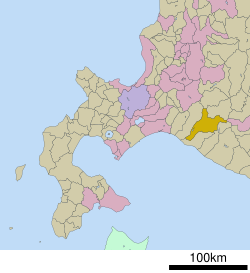Biratori, Hokkaido
Biratori
平取町 | |
|---|---|
Town | |
 Biratori Town hall | |
 Flag  Emblem | |
 Location of Biratori in Hokkaido (Hidaka Subprefecture) | |
 Biratori Location in Japan | |
| Coordinates: 42°35′N 142°8′E / 42.583°N 142.133°ECoordinates: 42°35′N 142°8′E / 42.583°N 142.133°E | |
| Country | Japan |
| Region | Hokkaido |
| Prefecture | Hokkaido (Hidaka Subprefecture) |
| District | Saru |
| Government | |
| • Mayor | |
| Area | |
| • Total | 743.16 km2 (286.94 sq mi) |
| Population (September 30, 2016) | |
| • Total | 5,305 |
| • Density | 7.1/km2 (18/sq mi) |
| Time zone | UTC+09:00 (JST) |
| City hall address | 28, Honchō, Biratori-chō, Saru-gun, Hokkaidō 055-0192 |
| Website | www |
| Symbols | |
| Bird | Great spotted woodpecker |
| Flower | Lily of the Valley |
| Tree | Katsura (Cercidiphyllum japonicum) |
Biratori (平取町, Biratori-chō) (Ainu: ピラ・ウトゥル, romanized: pira-utur[1]) is a town located in Hidaka Subprefecture, Hokkaido, Japan. The name of the town means 'between the rocky cliffs' in the Ainu language.[2]
As of September 2016, the town has an estimated population of 5,305 and a density of 7.1 persons per km2. The total area is 743.16 km2.
Ainu culture[]
The Nibutani Dam was constructed in Nibutani (二風谷) district on the Saru River, though there was a strong objection due to a sacred meaning of the place for indigenous Ainu people. Nibutani is the site of the Ainu Cultural center. Nibutani's best known son is perhaps Shigeru Kayano, a 20th-century advocate for the Ainu and Ainu language and culture. The cultural landscape along the Saru River consisting of Ainu traditions and modern settlement within Biratori has been designated an Important Cultural Landscape.[3]
Economy[]
Biratori is primarily an agricultural town, growing many different kinds of fruits and vegetables for people and livestock. Tomatoes are one of the top products of the town. It was also known for its lumber industry.
Tourist attractions[]
Some noteworthy attractions in Biratori:
- Biratori Onsen Yukara
- Family Land
- Nibutani and the Nibutani Ainu Culture Museum
- Suzuran Field in Memu, where Lily of the Valley (also known as Maybells) bloom from May to June. The field covers 15 hectares and is the largest in Japan. It opened to the public in 1963, but had to be closed in 1975 due to damage from overpicking and trampling. It was able to open again ten years later..
- The UFO park (Set up as a UFO observation platform, it was later closed in the 1970s-1980s.)
Notable people[]
- Shigeru Kayano (1926–2006), leading figure in the Ainu ethnic movement.
- Ryo Fukui (1948-2016), jazz pianist.
See also[]
- Cultural Landscapes of Japan
References[]
- ^ "北の生命をはぐくむ夫婦川" (PDF). MLIT. Retrieved July 30, 2017.
- ^ http://kai-hokkaido.com/en/town_vol31_profile/
- ^ "Database of Registered National Cultural Properties". Agency for Cultural Affairs. Retrieved 29 April 2011.
External links[]
![]() Media related to Biratori, Hokkaidō at Wikimedia Commons
Media related to Biratori, Hokkaidō at Wikimedia Commons
- Official Website (in Japanese)
- Biratori Nibutani Ainu Culture Museum Website (in Japanese)
- Nibutani Takumi no Michi website
- Towns in Hokkaido
- Biratori, Hokkaido
- Hokkaidō geography stubs
